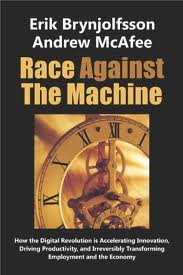 Will art ever be created by a machine? This is the question that is sometimes asked, late at night over a glass of wine. Perhaps it has been already. Authors Erik Brynjolfsson and and Andrew McAfee ask similar questions and explore the answers in their new book “Race Against the Machine: How the Digital Revolution is Accelerating.” Machines are playing an increasingly prevalent role in the work force and millions of jobs have been changed or replaced by computers or automated process. There is now a program called Stats Monkey that is being used to write about sports. Stats Monkey uses pattern recognition to generate summaries about sporting events. Although this program does not seem to be in usage by any major publication, it highlights the progress that has been made in the advancement of technology and the subsequent replacement of millions of workers by automated, computer controlled devices.
For now, the arts world can sigh with relief. It seems as though most endeavors which require intuition are safe from encroachment by computerized processes. We can assume that artists of all stripes are considered “high-skilled” and are intuitive in the creation process. Both of these characteristics make artists of all stripes the safest categories of workers at this point in time. The pursuit of making art isn’t simple. Artists of all kinds exist within a complex cultural context and react intuitively to it. This context also makes it extremely difficult for machines to interact. You could argue that Heather Knight’s Silicon Based Comedy is the first inroad on this front, but it still seems a bit far away. The complex human interactions intrinsic in the performing arts are a distant land from the world of automated tasks and promise to remain that way for quite some time.
Will art ever be created by a machine? This is the question that is sometimes asked, late at night over a glass of wine. Perhaps it has been already. Authors Erik Brynjolfsson and and Andrew McAfee ask similar questions and explore the answers in their new book “Race Against the Machine: How the Digital Revolution is Accelerating.” Machines are playing an increasingly prevalent role in the work force and millions of jobs have been changed or replaced by computers or automated process. There is now a program called Stats Monkey that is being used to write about sports. Stats Monkey uses pattern recognition to generate summaries about sporting events. Although this program does not seem to be in usage by any major publication, it highlights the progress that has been made in the advancement of technology and the subsequent replacement of millions of workers by automated, computer controlled devices.
For now, the arts world can sigh with relief. It seems as though most endeavors which require intuition are safe from encroachment by computerized processes. We can assume that artists of all stripes are considered “high-skilled” and are intuitive in the creation process. Both of these characteristics make artists of all stripes the safest categories of workers at this point in time. The pursuit of making art isn’t simple. Artists of all kinds exist within a complex cultural context and react intuitively to it. This context also makes it extremely difficult for machines to interact. You could argue that Heather Knight’s Silicon Based Comedy is the first inroad on this front, but it still seems a bit far away. The complex human interactions intrinsic in the performing arts are a distant land from the world of automated tasks and promise to remain that way for quite some time.
Another barrier to program or automaton generation of art in all forms is the fact that there is a plethora of artists who are working in the market for little or no money. From the standpoint of economics the lack of money in the majority of the arts field gives developers little reason to make inroads artistic process by replacing people with automation. Aside from the rockstar phenomena in the arts world, there simply isn’t the money in it to make it worth the time.
As technology speeds along we can be assured that these advancements will affect the arts. Already kickstarter promises to reshape the field of development in the arts by cutting out the administrative middleman and connecting artists directly to funders. Will increasingly sophisticated templates and design programs begin to make inroads into graphic design? Will marketing in social media be able to be automated? Will marketing in general be able to be automated. Certain facilities tasks are already being monitored by computers. Vacuuming lobby or gallery floors could be taken over by a fleet of roomba robots.
How will the future of technology manifest in the arts world? Surely at some point in time it is conceivable that a computer will generate a work of art and sell to some museum. This will inevitably make the news. This will spark controversy. Will actors be replaced through cgi? Well, the clear answer to that is not yet. Stage actors are even safer from replacement, but how about stage crews?
It is impossible to discern how exactly machines will interact with the arts. Watching the development of cutting edge technologies can gives clues. Possibilities to interact with our patrons lie largely untapped in the areas of 3d, holography, and new software applications. As with other industries, it is incumbent on artists to watch the horizon and harness technology as it comes into being, otherwise we end up being reactive and being blind-sided by change.
